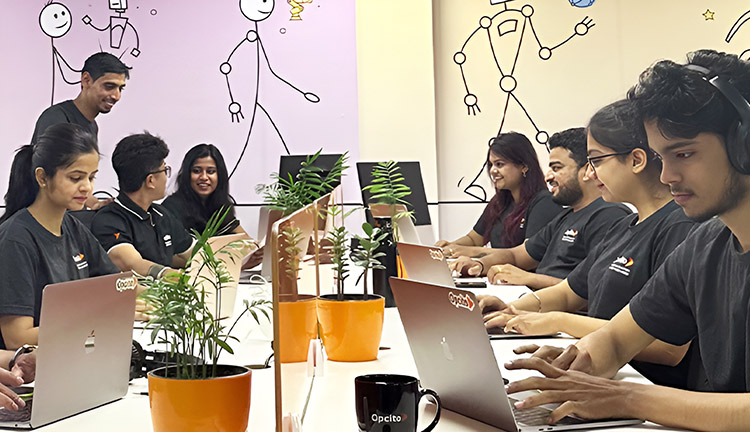What is Model Context Protocol (MCP) and why it matters for AI developers

Posted By
Sachin Warke

Artificial intelligence has grown beyond chatbots and text completion. It’s now taking action across enterprise tools and workflows. Yet even the most advanced LLMs still struggle to interact with business systems in a secure and context-aware way.
That gap between what AI knows and what it can do led to the Model Context Protocol (MCP). It was created to address a clear challenge: helping AI systems securely connect to enterprise data and tools. MCP gives models a shared language to collaborate and take meaningful action across systems.
There is clear momentum. According to MarketsandMarkets, the enterprise agentic AI market will grow from USD 6.76 billion in 2025 to USD 46.04 billion by 2030. It signals a massive shift toward intelligent automation inside enterprises.
What problem does the Model Context Protocol solve
For years, connecting AI to business systems meant building custom APIs or plugins for every use case. Developers had to create and maintain separate integrations for CRMs, ticketing systems, databases, and communication platforms. These integrations often broke when data formats changed or when the LLM generated unpredictable requests.
Model Context Protocol simplifies this by creating a consistent, language-agnostic interface between the AI and tools. Instead of building a new connector for every application, MCP servers act as a single, managed bridge.
This allows organizations to:
- Enable AI automation without exposing sensitive APIs directly.
- Add or replace tools without retraining the model.
- Centralize access control, monitoring, and auditing.
In short, MCP for AI solves the messy problem of safely and scalably integrating intelligent models with enterprise systems.
The evolution from APIs and plugins to MCP
APIs and plugins helped early AI agents perform simple tasks like sending an email, retrieving a calendar event, or generating a report. But as enterprises expanded their AI ambitions, they hit a wall. APIs are rigid. Each integration requires its own logic, error handling, and authentication. Plugins created silos, limiting interoperability between different AI systems.
MCP integration represents the next stage. It's designed as a standardized protocol that lets any compliant model interact with any compliant tool through an MCP server. That means developers and architects can build once and connect anywhere without having to reinvent access rules or security layers.
This shift is as significant as moving from desktop software to cloud computing. It changes how AI systems are built, deployed, and maintained at scale.
Understanding the MCP architecture
To understand how MCP implementation works, it helps to visualize the architecture. The Model Context Protocol defines four key components:
- The client: The client is typically the AI model — for example, a large language model running on an orchestration platform. It sends structured requests through MCP to access data or perform actions.
- The server: The MCP server is the gateway that translates AI requests into tool-specific actions. It enforces permissions, validates inputs, and manages session context. This layer is critical for security and reliability.
- The tools: These are the connected systems, such as your CRM, database, calendar, or document store. Through MCP, these tools become safely accessible to the AI model under strict policy control.
- The model interface: This layer defines how the AI interprets responses and uses them for reasoning. It ensures that the AI remains aware of context across multiple tool interactions.
Together, these components create a secure, modular framework that can scale across multiple environments, from pilot projects to enterprise-grade deployments.
Building a reliable MCP server takes a deep understanding of permissioning, logging, and fault tolerance to ensure every interaction between AI tools and enterprise systems is reliable, traceable, and compliant. An experienced MCP implementation partner can simplify this process by designing architectures that are secure, scalable, and ready for production use.
Where MCP fits in modern AI automation frameworks
Frameworks like LangChain and OpenAI's tool calling have already popularized the idea of AI agents performing real tasks. But these frameworks often depend on ad hoc connectors and lack standardization.
MCP for AI introduces a universal approach. Instead of hard-coding integrations, developers can connect these frameworks through a compliant MCP server. This makes AI automation more modular and portable across ecosystems.
For example:
- A financial firm could use MCP to connect its LLM with real-time market data feeds.
- A healthcare company could safely access patient scheduling data without violating access policies.
- A SaaS provider could integrate AI directly into its internal developer tools to speed ticket resolution.
By adopting MCP implementation early, enterprises future-proof their AI infrastructure and avoid vendor lock-in.
Early adoption and ecosystem growth
The MCP ecosystem is still young but rapidly expanding. Early adopters include cloud vendors, AI research labs, and enterprise AI service providers building modular MCP services for internal use.
The momentum resembles the early days of REST APIs — a few implementations at first, then exponential growth once the standard proved reliable. The open nature of the Model Context Protocol allows innovation across languages, platforms, and industries.
We’re already seeing prototypes of MCP images, such as visual representations of how AI interacts with systems being used for monitoring and debugging. As tooling matures, these will make MCP architectures easier to visualize and optimize.
From theory to enterprise deployment
Building a proof of concept is one thing; scaling MCP into a production environment is another. The real difference comes down to architecture. Opcito’s MCP development services focus on building that foundation with security, resilience, and scalability at its core.
Our teams focus on:
- Designing resilient MCP servers that scale under load.
- Implementing fine-grained access controls for secure AI-tool interactions.
- Integrating monitoring, tracing, and failover mechanisms.
At Opcito, we’re building MCP server architectures that make this bridge robust, secure, and enterprise-ready. Explore how our MCP server development expertise helps teams go from pilot to production. Connect with us at contact@opcito.com for more information.




















